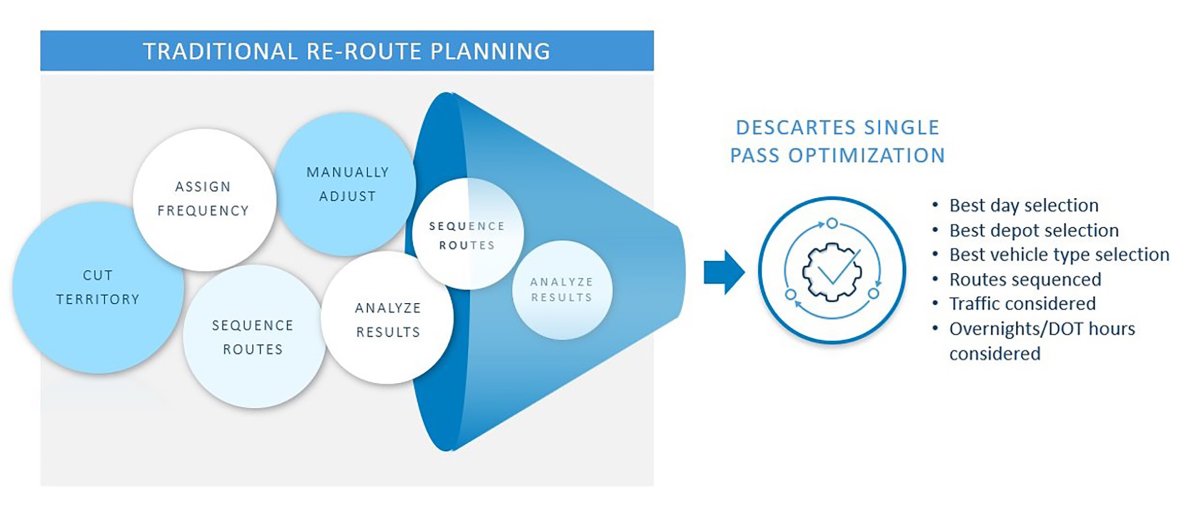When to Use Strategic Planning Software for Delivery Management

The strategic choices you make today will impact delivery costs for years to come. Yet many businesses rely on tribal knowledge and daily routing tools to make long-term decisions about territories, fleet composition and even depot locations.
Strategic planning software helps you to make data-driven decisions that reduce costs and improve customer experience. As well as building reliable fixed routes, businesses can run simulations to test the outcome of operational changes.
Strategic planning could give your business an edge, check out the use cases below.
In this article:
The case for strategic route planning
Strategic planning helps you to make decisions with far-reaching consequences for your fleet, such as:
- How many vehicles do you need?
- Where should your new depot be?
- What’s the best day to visit each client?
It isn’t feasible to make these kinds of decisions manually: The human brain simply can't weigh up every possible scenario.
But why not use your daily route planning software for this task?
While daily routing tools are powerful, they aren’t designed for strategic decision making. You would have to test each scenario one after the other, while still needing the software for daily route planning activities.
In contrast, strategic planning software tests multiple scenarios in parallel to produce feasible delivery plans that meet customer expectations.
Potential outcomes include:
- More consistent on-time deliveries
- Balanced routes and workloads
- Fewer routes and miles driven
- Efficient use of planners, drivers and vehicles

Who is strategic planning for?
Strategic planning is ideal for companies with complex and costly delivery operations. Here are some typical characteristics:
- Multiple delivery depots
- Regularly recurring customers with time-sensitive deliveries
- Multiple territories and fixed routes
- Planning horizons that span weeks or months
- Mix of high- and low-priority customers
- Multiple vehicle types
Distributors should also take a strategic approach when making acquisitions, expanding into new markets or adding large new customers. Strategic planning can predict the capacity and fleet composition that will be needed going forward.
Use cases for strategic planning
Here are some common ways that strategic planning can set you up for long-term success.
1. Strategic route recutting
"How can I create feasible, efficient routes that meet anticipated customer demands?"
Fixed routes are predetermined sequences that stay the same over a period of weeks or months. You might choose to recut these routes weekly, monthly, seasonally, or whenever your customer base changes significantly.
Taking on this process manually is a daunting task. Planners have to contend with a huge number of variables, not limited to:
- Promised time windows
- Varying product types, capacities and sizes
- Probable order volumes
- Commercial road restrictions
- Multiple depots and vehicle types
- Frequency patterns (e.g. two days a week with at least two days in between)
- Drivers’ hours
- Territories
- Driver to customer restrictions (e.g. one-to-one relationships)
This complexity means that often, routes aren’t revisited frequently enough – and customer service suffers as a result.
Strategic planning software allows you to build fixed routes based on real data, taking into account business goals, contractual obligations and order probability. And with optimal fixed routes in place, it’s easy to dynamically update the sequence as-and-when real orders come in.
By automating this time-consuming process, you’ll be able to provide a consistent delivery experience that aligns with customer expectations.

Strategic route recutting in practice
Arctic Glacier is a provider of premium ice products and services. Using the strategic route planning solution from Descartes, the company is now able to replan fixed routes more frequently. This allows Arctic Glacier to minimise fuel costs and manage seasonal demand swings.
“With Descartes strategic route planning, we can create master routes every 1-2 weeks, instead of monthly or quarterly, to continually fine tune delivery productivity and cost-effectiveness.”
Elizabeth DiFazio, Routing Director at Arctic Glacier
2. Frequency planning and day selection
"How can I make cost-effective deliveries while meeting the needs of each contract?"
In business to business (B2B) sectors, you may be visiting the same client once, twice or three times a week. You might have some deliveries guaranteed by a certain day, and some customers who require you to leave a certain number of days in between deliveries.
Strategic planning determines the best day(s) to deliver to each client, based on these criteria. In addition, the software can take into account business goals such as increasing delivery density.
This approach allows you to honour customer commitments while reducing overall delivery costs.

3. Choice of vehicles
"How do I build a cost-effective fleet that aligns with our long-term delivery needs?"
Strategic planning software can run simulations to choose the best composition for your fleet. Should you favour light utility vehicles? Heavy goods vehicles? Or vehicles that can drive in low-emission zones? What about refrigerated trucks?
The software considers factors such as order characteristics, sales volumes and road restrictions to suggest the best mix of vehicles.
These choices will stay with your fleet for years to come, so they shouldn’t be taken lightly. The right fleet mix will allow you to minimise fuel costsand scale with demand.
4. Best depot selection
"For each customer, which depot is best to minimise delivery costs and miles driven?"
Depot selection has a huge impact on the cost-effectiveness of the last mile: A small reduction in mileage per delivery can add up to thousands of miles over the course of a year. In addition, optimised travel times make it easier to keep delivery promises.
Yet all too often, depots are selected based on arbitrarily drawn territories.
Strategic planning software uses real data to work out the optimal depot from which to serve each customer. You can optimise towards business goals such as:
- Reducing costs
- Minimising miles driven
- Balancing workloads
To take this a step further, strategic modelling will help you choose the best location for new depots as and when your business expands.

5. Territory planning
"How can I balance territories so that each route takes the same amount of time to serve?"
We typically see businesses drawing up territories based on a single parameter such as revenue or number of stops, ignoring other variables such as weight, traffic patterns and overnights. Only then are service days assigned, and routes sequenced.
This step-by-step approach can result in inefficiencies, unassigned stops and concurrent time windows that need to be manually untangled. In the end, distributors risk falling short of service level agreements (SLAs).
Strategic planning software can carve up territories based on many factors simultaneously. It can also balance workloads based on a range of goals including cost, delivery density and percentage of vehicle capacity used.
This can take place in a single pass with frequency planning, day selection and routing – there’s no need to manually intervene at each step.
Territory balancing in practice
Gateway Services Inc. specialises in delivering pet aftercare services, including memorials and keepsakes for beloved pets. Previously, drivers experienced significant route overlap, leading to excessive drive times and inefficient resource allocation. With Descartes, Gateway Services optimised routes to balance workloads and improve service coverage.

6. “What-if?” scenarios
"What happens to delivery operations if sales grow by 20%?"
When it comes to significant operational decisions, there’s no need to rely on a hunch. Today’s software can simulate alternative policies and practices to test what works best.
We see distributors testing scenarios such as:
- Closing or opening a new depot
- Changing from a two-hour to a three-hour delivery window
- Adding a large new customer to their network
- Adding customers in a new location
- Increasing or decreasing the length of drivers’ workdays
As demand grows or shrinks, software can predict the costs and the delivery capacity that will be needed going forward.
When tendering to a new customer, you might use strategic planning to inform your bidding strategy and ensure that deliveries remain profitable.
“What-if?” scenarios in practice
Topps Tiles wanted to be able to explore route planning and optimisation at a more strategic level, something which was too resource-intensive for the team to undertake manually.
The company wanted to run different scenarios where they might bring the delivery of our commercial orders in-house, rather than relying on external delivery partners - particularly when the pallet order volumes were relatively low.
“Descartes’ strategic route modelling capabilities ... enabled us to model delivery scenarios and make more informed strategic decisions, which would have been nearly impossible with traditional resource-intensive analytical methods.”
Simon Macdonald, National Transport Manager, Topps Tiles
Single pass strategic modelling
Traditional strategic route planning solutions take several steps to produce an optimal plan. Territories must be cut, then delivery frequencies assigned, delivery days selected, and routes sequenced.
With this approach, frequency planning is a matter of guesswork. And each step may need to be repeated if it violates the parameters set out by the previous step.
That’s why Descartes takes a single pass approach to strategic planning: Territories, frequencies, delivery days and routes are optimised at the same time. There’s no need to guess the ideal frequency before sequencing routes.

In addition, the software can consider multiple “what if?” scenarios simultaneously.
This method makes it much easier to strategically reset your delivery operations and respond to changing demands. In one step, you can optimise deliveries to produce the least costly fixed routes, reduce the time per route, balance workloads and meet customer demands.
Getting started with strategic planning
Strategic planning software gives businesses the confidence to make smarter long-term decisions. By replacing manual guesswork with data-driven modelling, you can build an efficient delivery operation that’s better aligned with your business goals.
Get in touch today to find out how Descartes could help.

